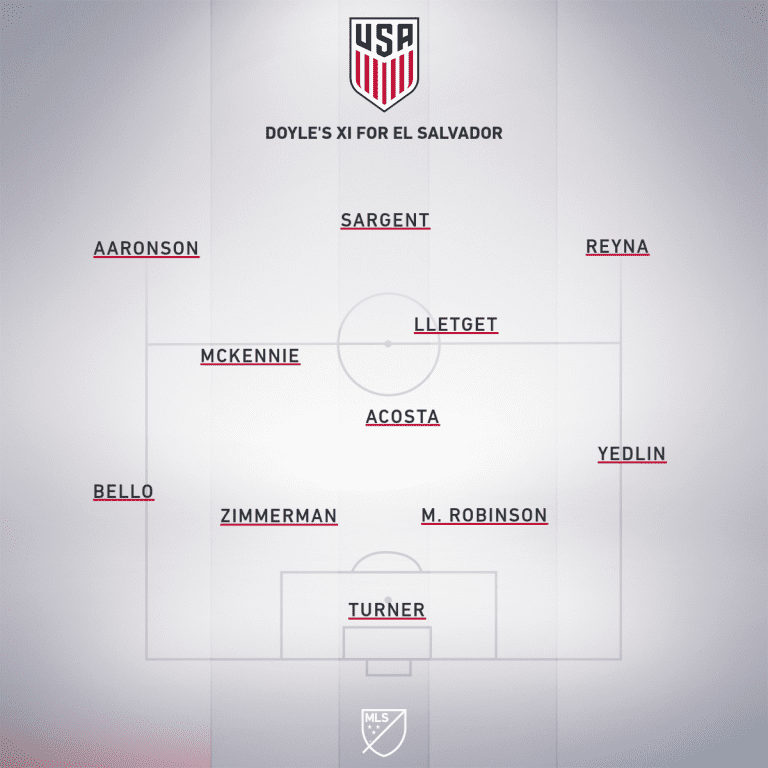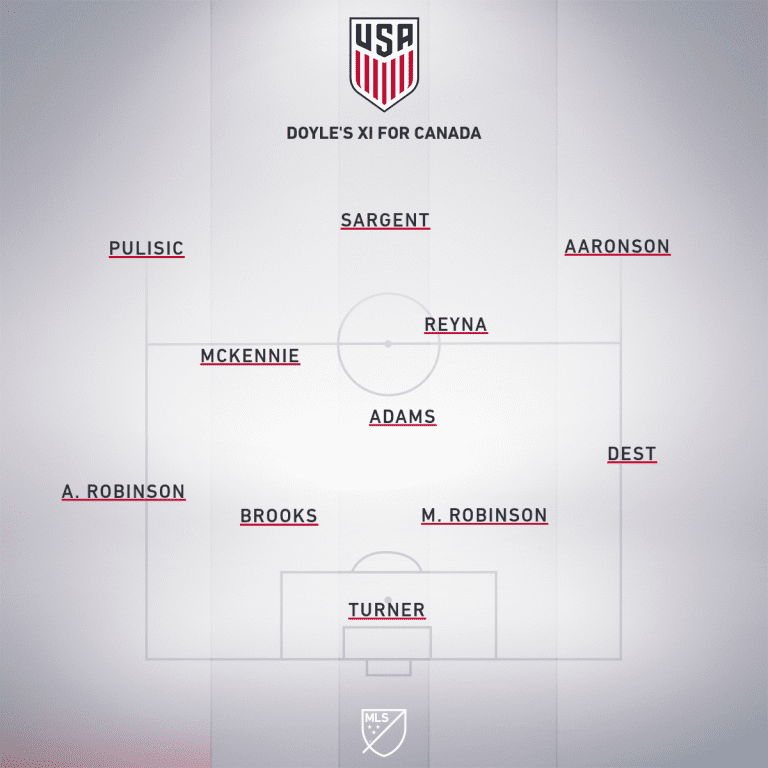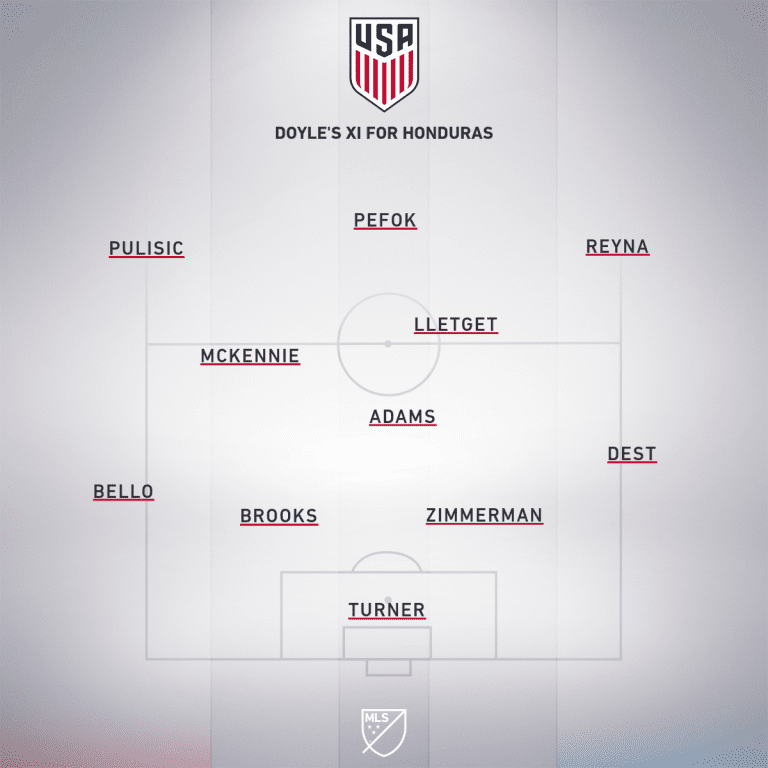And now, it is time.
Four long years after the failure at Couva, the US men’s national team are about to embark upon their next qualification cycle, one delayed and marred and eventually reconfigured by a global pandemic. Over the next seven days the US will play three games, an unprecedentedly compressed schedule, and at the end of it will be more than 20% of the way through the Octagonal.
Welcome back to World Cup Qualifying.
There are two ways to look at this new format, both of which I think work in favor of the US:
- Going from the old Hexagonal (10 games) to the new Octagonal (14) games provides more room for error, i.e. more room for the truly talented teams to separate themselves from the pack. More games should produce a truer representation of who the region’s best are.
- The compact schedule should provide a real advantage to teams with meaningful depth. Three games with two international flights is a lot, but the reality for basically every Concacaf team is that this window, and the next, are more like five games in 14 days, given weekend club commitments. Add in some long flights -- not just for the US, mind you -- and a lot of tanks will be half-full, at best, for the first game of this window, let alone the third.
The US are one of the two best teams in the region, and one of the 10 best teams in the world if you put any stock into the FIFA Rankings. And the US are almost certainly the deepest team in the region, given that they just won the Gold Cup playing a team composed mostly of back-ups and, in some cases, very deep reserves.
None of this is a guarantee of advancement. But the way it’s set up plays to some obvious US strengths, and it’ll be up to head coach Gregg Berhalter to make sure those strengths define this cycle for the US.
The obvious way to do that is to rotate the hell out of the squad throughout this window. While fans obsess about throwing a Best XI US squad out there for every game, Berhalter has been resolute about the fact that he sees the qualifying group as 30-strong. For this particular window he called in 26, a number that got whittled down by one after Tim Weah had to withdraw due to a muscle injury. And at least for the El Salvador game, it appears that one other winger will be missing:
So yeah, with Christian Pulisic staying in Nashville it seems like the US will be without two of their top three wingers, including the most accomplished player on the squad, for their first qualifier in four years. This is the nature of World Cup qualifying, and why it was so encouraging to see so many young players evolve into serious contributors -- often focal points -- at their respective clubs over the past 18 months.
Let’s dive into how I think Berhalter will handle squad rotation throughout the window:
Opponent brief
El Salvador, coached by former USMNT great Hugo Perez, who was also an effective and lamentably short-time US youth national team coach, are in the final round for just the second time in the past 20 years. They are clearly very happy to be here.
They will not just play like they’re happy to be here, though. Perez has his side come out and really try to play good soccer, almost always out of a 4-3-3 (sometimes a 4-2-3-1) with fullbacks who push high and an interchanging frontline -- in part because they lack a go-to No. 9. The days of Raul Diaz Arce are a distant memory.
There is a pretty significant talent gap between these two teams. I think you could credibly argue that Seattle Sounders right back Alex Roldan is the best player in the squad, though he’s more likely to play central midfield given that 1) the other guy who’s got an argument for their best player is Bryan Tamacas, who’s also a right back, and 2) Roldan is most likely needed at central midfield with Houston's Darwin Ceren picking up a knock.
Set pieces should be a huge US advantage.

US lineup notes
• Gio Reyna, who is both indestructible and made for Concacaf, and Weston McKennie, who has fresh legs given his light recent club workload, are the only US players I’m planning to have in the XI for all three games.
• There’s no way I was going to start John Brooks, who has notoriously struggled in the heat of Central America and is coming off a full 90 last weekend, in a pair of road qualifiers this round. So Walker Zimmerman, who has some Concacaf experience thanks to his CCL reps, gets the start in Brooks’ place.
• Miles Robinson is an easy call here despite his monumental recent workload for Atlanta, and honestly I feel the same way about George Bello. Both guys are in the best form of their young careers, both have Concacaf experience at the club level and in the Gold Cup, and both acquitted themselves well in the cauldron of a Gold Cup final vs. El Tri. Robinson scored the winning goal, and Bello, in Herculez Gomez’s words, “pocketed Tecatito Corona like nobody in Concacaf has ever been able to do.”
I want that Concacaf experience out there for Game 1.
• That also explains DeAndre Yedlin over Sergino Dest.
• Tyler Adams has Concacaf experience as well, and I think he’s the future captain of this team. But he also has fragile hamstrings, is coming off 84 minutes with RB Leipzig, and I am not going to run him into the ground here. I also damn near completely trust Kellyn Acosta given his performance in the Gold Cup, as well as his previous experience both in World Cup qualifying and in CCL.
I also want to make sure that the team’s got fresh legs in central midfield for Game 2, at home against Canada, so Adams is going to have to sit here. He’ll be angry, but he’ll understand.
• The above is why I’d pick Sebastian Lletget to start even if Yunus Musah and/or Paxton Pomykal were available. Hopefully we’ll get to see them both during the next window.
• Josh Sargent gets the start because he is easily the best defensive center forward of the trio, and I want him making life miserable for the El Salvador center backs. They absolutely will try to build out against a US press, and turnovers are the most valuable currency in international soccer.
• Brenden Aaronson is the easy pick ahead of Konrad de la Fuente at the left winger spot given his deeper experience with the group and familiarity with the system. And yeah, his defensive work is a level above what I’ve seen from Konrad thus far.
• I know Berhalter has intimated that he’s going to rotate ‘keepers, but I will be surprised if Matt Turner hasn’t earned the No. 1 kit at this point.
Opponent brief
This is the most talented Canada side I’ve ever seen, one that was able to largely outplay the US in a 1-0 loss during the Gold Cup group stage, and one that went toe-to-toe with Mexico in a 2-1 loss in the semifinals. They did this without their three best attackers: Alphonso Davies (the best player in the region), Jonathan David and Cyle Larin.
They have depth and solidity almost everywhere* on the field, and high-level match-winners when they trot their first team out. For the most part the drop-off from first-choice to second-choice isn’t catastrophic, though they can struggle to move the ball crisply out of central midfield if Stephen Eustaquio is given a night off.
(*) Lucas Cavallini’s injury -- he’s on the roster, though it’s doubtful he can go a full 90 -- leaves them a little thin at center forward behind Larin.
Head coach John Herdman has generally had his team come out in a 3-5-2 over the past year or so, which has gotten the best out of Davies on the left as well as right wingbacks Richie Laryea and Tajon Buchanan. Crucially, it’s also helped solidify the backline, which is easily the weakest and shallowest part of this team.
How Herdman handles rotation among his center backs will go a long way toward determining how smooth a qualification process Canada have.
I’ll go ahead and offer my two cents: Canada’s home games this window vs. Honduras and El Salvador are infinitely more important to their chances than the roadie in Nashville. If I was Herdman I would be doing everything in my power to make sure Davies, David, Larin and Eustaquio are fresh for the first and third games of this window, even if it considerably lowers the percentage that a positive outcome against the US is likely in the second game.

US lineup notes
• It’s maybe a little bit of wishful thinking to have Pulisic in the XI, but I’m throwing a bit of caution to the wind here. He’s the USMNT’s best player -- even if he’s rarely played like it in the Red, White & Blue of late -- and so here he is.
The ideal for the US is for Pulisic to get on the ball in isolation against whoever Canada’s right center back happens to be on the day. Quick transition moments off of midfield turnovers with one of Buchanan or Laryea (I assume those guys will split time at RWB) are what to look for.
• Sargent and Aaronson both get the starts here, again for their defense and familiarity with the US scheme. The way to break this Canada side is to press the hell out of that backline and force them into turnovers, and the way to neutralize those wingbacks is to turn Herdman’s 3-5-2 into a 5-3-2.
• I said when the roster was released that it screams “We’re gonna try Gio at the 8 during this window!” and here we are. Reyna’s been playing as something of an 8 with Dortmund, and while it hasn’t exactly been smooth sailing, it’s not like he’s been bad there, either.
More to the point, though: I think putting him in this role really complicates things for Canada’s midfield defensive structure, which could/would have the knock-on effect of complicating things for their backline. Canada do not scramble well defensively, and Reyna’s willingness and ability to beat individuals off the dribble by its very nature forces teams to scramble. That, in turn, creates very exploitable gaps for the likes of Pulisic and Aaronson.
• Part of the reason I feel comfortable with Reyna in this role is because Adams is back at defensive midfield, and McKennie is still in there as the No. 8. I don’t think this is complicated at all.
• Simple squad rotation at center back, with Brooks coming in for Zimmerman. Robinson gets another start.
• Squad rotation as well at the fullback slots. I don’t love playing Antonee Robinson and Dest at the same time -- both guys have questionable defensive instincts and are prone to turnovers in bad spots -- but again, this is a luxury afforded by having Adams out there at d-mid. He puts out a lot of fires.
The other thing to keep in mind is that while Dest can be flammable defensively, he can also on occasion be very, very good. One of those occasions was in the Nations League quarterfinals head-to-head against Davies two years ago. I think it’s pretty clear that Sergino gets up for big 1-v-1 matchups (though again, no guarantee it’s Davies he’s going against).
• Again I have Turner in for Zack Steffen, but if there’s a game to rotate it’s probably this one.
Opponent brief
Los Catrachos, like Costa Rica and Panama, are somewhat caught between generations. And so this roster’s a mix of familiar old faces at the very end of their run -- Maynor Figueroa and Boniek Garcia are still here, though Roger Espinoza and Emilio Izaguirre no longer are -- and a bunch of younger guys who haven’t quite proved it yet, and don’t quite seem to have the same upside as their predecessors.
Complicating things is that their best player, Alberth Elis, is still recovering from a foot injury suffered during the Gold Cup. He's not available.
So it’s not a full-strength squad, nor is it one that has a lot of creative impetus. We saw that in the Nations League when Honduras generated just four shots against the US and were only dangerous in transition.
Those transition moments are still their bread and butter, even without Elis. Romell Quioto and Anthony “Choco” Lozano in the open field are a nightmare for any team in Concacaf, and anyone who’s ever watched Honduras play knows that they’re able to create those transition moments by being almost unimaginably physical.
They are still likely the most physical team in the region. That said, head coach Fabian Coito has tried to instill a little bit more finesse to the side in his two years at the helm, primarily out of a 4-2-3-1, though it’s been relatively slow going.

US lineup notes
• Is Pulisic fit enough to go twice in a row on short rest? My money’s on “yes,” and it’s worth noting that the Honduras FA did the US a solid here by scheduling the game at night instead of the blazing mid-afternoon sun, as in previous cycles.
Even if he can go only 45 minutes, I think I’m starting Pulisic here. The right side of that Honduras backline is a weak spot, and I want the US to set the tone by going right at them. Four years ago the US allowed Honduras to set the tone through Elis, and it took a late, scrappy Bobby Wood goal for the US to come out with a point.
The flip side of this argument is that Honduras don’t have the depth to rotate much, and might be out of gas by the second half of the final game of this window. So it could be worth keeping Pulisic in reserve to run at some very tired legs for the final 45 minutes.
Hopefully he’s 180-minutes fit for this window, though, and this is all moot.
• I have Jordan Pefok starting this game, as I expect Sargent’s tank to be empty after the first two. Pefok isn’t a particularly good defensive presence, though he makes better runs than Sargent and is a big body in the box on set pieces, both attacking and defending. That matters a ton on the road in qualifiers.
• Reyna back up along the front line with Adams, McKennie and Lletget in central midfield. I do think, though, that there’s a very compelling argument to make it Adams, McKennie and Acosta, with Kellyn as the No. 6 and Adams as an advanced destroyer of a No. 8.
That is the gegenpressing option, and though we haven’t seen it from Berhalter yet, I’ll be surprised if he hasn’t at least considered it.
• More simple squad rotation at center back, this time with Miles Robinson sitting and the Brooks/Zimmerman pair getting a run-out. I am a little bit worried about a slight lack of footspeed in that duo, but Mark McKenzie’s not exactly a burner himself. This is where the injury to Aaron Long and the only-recently-resolved club limbo of Chris Richards really hurt.
• At some point we’ve got to trust Dest on the road in a qualifier. Might as well get it done now.
• Bello over Robinson is an easy choice for me here for defensive reasons.
James Sands' presence
I have James Sands in every gameday roster in case Berhalter sees a compelling reason to switch to a back three (or five). I’m glad Sands is on the roster -- he’s got a huge future with the US -- but if he’s ever out there in a back four, I think it means something’s gone wrong.
That’s not to cast aspersions upon his Gold Cup performance. He battled and did better than anyone had a right to expect given the ask, but he’s not a natural center back in a four even if he’s listed as a center back on the roster.
Ricardo Pepi's possible role
Ricardo Pepi is the “break in case of emergency” goalscoring sub. He has become a much more complete No. 9 over the past year, but I can’t imagine him starting any of these games.
Same goes for Konrad, who is not only an option as a change-of-pace winger sub, but also a YOLO-style attacking wingback choice if the situation calls for it. Let’s hope not, though.
What awaits Cristian Roldan
I don’t think Cristian Roldan is on this roster to start, and am hoping his role is “we have a big lead, let’s get Cristian on so that Wes can get 25 minutes of rest.”
That said, if there is a late-game “press ‘em to death and win set pieces” situation, Roldan is very valuable.
Tim Ream's spot
The one player I haven’t mentioned throughout is Tim Ream, who’s mostly served as Brooks’ back-up, but also occasionally as a LB in a lopsided back four, or as a LCB in a back three (or five).
I get why Ream is there, and he’s been better for the US over the past year than the fanbase generally appreciates. But my hope is that his role is one of moral support more than anything else.













